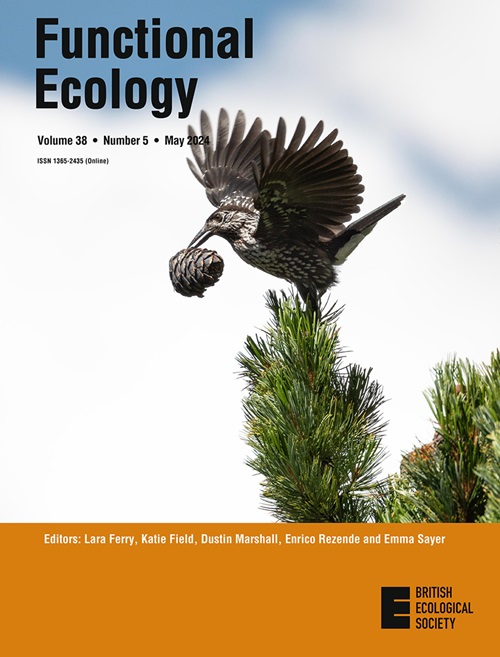Changing plant phosphorus acquisition strategies in relation to altered soil phosphorus fractions after wetland drainage
IF 4.6
1区 环境科学与生态学
Q1 ECOLOGY
引用次数: 0
Abstract

湿地排水后植物磷获取策略的改变与土壤磷组分的改变之间的关系
植物磷(P)获取策略被认为是植物演替的内在驱动力。然而,植物磷获取策略的变化与湿地排水后土壤磷含量变化的关系仍不清楚。为了解决这个问题,我们在六个经历了长期(20 年)人工排水的不同湿地进行了研究,并以邻近的积水湿地作为对照。我们分析了植物群落组成、生物量和土壤钾组分,并根据土壤酸性磷酸酶活性、植物对钾的吸收效率和土壤丛枝菌根真菌(AMF)含量确定了三种植物钾获取策略。我们发现,土壤钙结合钾(PCa)和酶提取钾(Penzyme)是影响植物钾获取的关键因素。土壤钙结合钾与酸性磷酸酶活性呈负相关,但与 AMF 含量呈正相关。土壤酵素对钾吸收效率有负面影响。根据植物丰富度和组成的变化,湿地被分为三种类型,每种类型都表现出不同的植物钾获取策略。排水后这些策略的变化与土壤钾组分的变化相对应。总之,我们的研究强调了土壤钾组分在解释湿地排水后植物钾获取策略中的作用,表明了钾对植物演替和生态系统服务的调节作用。在期刊博客上免费阅读本文的通俗摘要。
本文章由计算机程序翻译,如有差异,请以英文原文为准。
求助全文
约1分钟内获得全文
求助全文
来源期刊

Functional Ecology
环境科学-生态学
CiteScore
9.00
自引率
1.90%
发文量
243
审稿时长
4 months
期刊介绍:
Functional Ecology publishes high-impact papers that enable a mechanistic understanding of ecological pattern and process from the organismic to the ecosystem scale. Because of the multifaceted nature of this challenge, papers can be based on a wide range of approaches. Thus, manuscripts may vary from physiological, genetics, life-history, and behavioural perspectives for organismal studies to community and biogeochemical studies when the goal is to understand ecosystem and larger scale ecological phenomena. We believe that the diverse nature of our journal is a strength, not a weakness, and we are open-minded about the variety of data, research approaches and types of studies that we publish. Certain key areas will continue to be emphasized: studies that integrate genomics with ecology, studies that examine how key aspects of physiology (e.g., stress) impact the ecology of animals and plants, or vice versa, and how evolution shapes interactions among function and ecological traits. Ecology has increasingly moved towards the realization that organismal traits and activities are vital for understanding community dynamics and ecosystem processes, particularly in response to the rapid global changes occurring in earth’s environment, and Functional Ecology aims to publish such integrative papers.
 求助内容:
求助内容: 应助结果提醒方式:
应助结果提醒方式:


